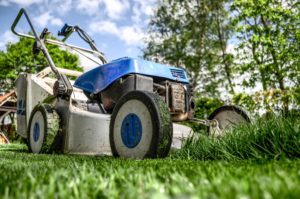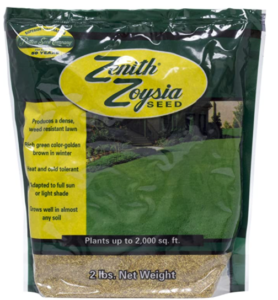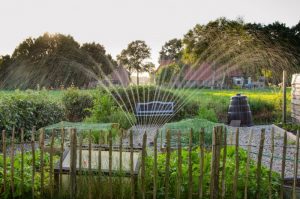Zoysia grass storm has not only swept the golf space, but many more homeowners are fast embracing it in their lawn care goals, mainly considering the benefits it comes with.
This turfgrass is low in maintenance, requires less water, tolerates heavy traffic. Above all, it’s a pest, drought, and weed resistant species. Zoysiagrass became quite popular in the United States in 1895, when the first American lawns emerged.
To date, numerous golf courses have embraced it, hailing its ground-leveling ability that helps keep the ball at a hittable position; and its self-filling nature post damage.
Facts About Zoysia Grass
- It’s commonly known as warm-weather grass and is native to Asia (Korea)
- It’s a perennial grass that grows 6-12 inches
- It thrives in full sun (though it can tolerate a bit of shade) in average soils with good drainage—with a slightly acidic pH (6.0-6.6).
- Usually dark green with a medium texture.
- Goes dormant in cold weather and turns brown. Therefore, most suitable for the sunny and warm climate.
- Thrives in USDA hardiness zones 5-10
Zoysia Varieties
There are three main varieties of zoysiagrass; Z. matrella and Z. japonica—the turf varieties; and Z. tenuifolia—the groundcover or ornamental type.
Each of the three has been bred into various strains with varying textures, durability, cold-hardiness, pest resistance, and colors.
Zoysia japonica
Also referred to as Korean lawn grass, Z. japonica is the most widely available variety of zoysia grass and exhibits the fastest growth habit. The seeds are the most widely available for planting in the United States.
It’s also the most cold-hardy with the highest drought tolerance ability. Cultivars include Meyer, Belair, and Zenith zoysia.
Zoysia matrella (Manila grass)
Z matrella features more delicate leaves and is denser than tenuifolia and japonica. It’s less cold-hardy; it tolerates a light frost but may suffer quite hard frosts. However, adequate moisture and sunlight can quickly heal from the beating and withstand heavy foot traffic, courtesy of its aggressive and dense growth.
Though aggressive and weed resistant, Z. matrella takes a few years to be established—during which it may require a bit more maintenance.
Zoysia tenuifolia
It’s commonly known as Korean velvet grass, with its popular cultivar being Emerald zoysia.
Though it features a beautiful soft fine texture, Z. tenuifolia isn’t very popular in lawns owing to its mound-like growth habit. Instead, most lawn care experts advocate for its use as an ornamental plant. Additionally, this species is even less cold-tolerant than the other varieties.

How and When to Plant a Zoysia Grass Lawn
Zoysiagrass is best planted from mid-spring to early summer to allow for adequate time to fill in and establish a deeper and extensive root system before winter.
Zoysia grass growing needs
Here are the basic things you need to grow a beautiful zoysiagrass lawn.
-
Amended soil
Zoysia grass tolerates many soils, including acidic soil, though a little tweaking of the medium with lime may be necessary, especially if the pH level falls below 6.0.
Ensure the soil is well-draining to encourage deep root development, which will, in turn, boost the turf’s drought tolerance ability.
-
Light
Zoysia requires full sun to develop and maintain a lavish dense carpet on a lawn.
Too much shade can quickly thin the grass, creating room for the weeds to thrive, further stressing the turf.
-
Water
Zoysia is drought tolerant but will appreciate an inch of water each week. This frequency may be reduced as required if you have clay or highly compact soil.
Irrigate early in the morning to allow the grass to dry fast, which will help prevent fungal diseases.
Also, ensure you water deeply to encourage a healthy, deep root system.
-
Fertilizer
Unlike most grasses, zoysia will do with just 1-3 lb of nitrogen per a thousand square feet lawn—depending on the soil type—less for clay and more for sandy.
Temperature and Humidity
Zoysia thrives in extremely warm to hot weather but will tolerate an extensive humidity range.
The ideal temperature is above 80 degrees.
Soil preparation
Like when planting other grasses, prepare the soil by removing all weeds and past grass (with their roots) as much as possible. Go ahead and till the lawn with a heavy-duty tiller set as deep as possible. Then level the soil, removing any stones and debris.
Note: Avoid walking on prepared soil.
Next, spread a layer of compost (3-6 inches) over the soil then till it in—to help provide a healthy and robust foundation for the turf; improve drainage, nutrient content, and water retention ability. Good soil preparation is also a great way to avert most future turf problems.
Planting zoysia from seed

- Using a spreader, seed your newly prepared bed uniformly—making sure to follow the instructions on the seed bag.
- Avoid over-seeding as that will only lead to competition for resources, thus resulting in seedling death.
- Rake the seeds lightly; ¼ inch into the topsoil.
- Water four to five times a day in the first month reduces gradually as the turf begins to thicken.
- However, prolong the irrigation and frequency if seedlings grow during the hot summer season.
- There would be no need for fertilizer if you incorporated compost during soil preparation.
- Mow once the lawn gets to over 2 inches tall, and again, once, before dormancy—to help encourage deep healthy root systems that will enable the grass to survive cold stress in the winter.
Growing from sod
Sod is the most expensive option for establishing a new lawn, yet the best way to ensure a weed-free zoysia lawn is a significant achievement in the landscaping world.
- Set the sod pieces over your selected lawn area—end-to-end tightly to help avoid overlaps and gaps.
- You also want to avoid the lining up of seams. Therefore, ensure you stagger the sod pieces in the adjacent rows.
- If possible, trim the corners of your zoysia grass sods for a proper fitting using a hatchet.
- Tamp down the sod lightly into the soil, then water immediately.
- Depending on the season, you may need to irrigate the sod two or three times a day (about 20 minutes for every session) to keep the sod consistently moist, especially in the first few weeks post-planting.
- Slowly cut down on watering once the lawn starts to grow actively—up until you’re ready to mow.
- Resume your regular watering schedule from this point on, and increase if need be, or when you notice fresh sod.
Note: Zoysia grass sods and plugs are best transplanted from spring to early summer.
Growing from Plugs

- The best thing about using plugs is that you have a high chance of success, whether establishing a brand new lawn or just filling the worn-out spots.
- Just in case you didn’t know, plugs are simply two to four-inch cores of sod with stolons, leaves, rhizomes, and a root system.
- Dig holes that are larger than your grass plugs (at your desired spacing) in a checkerboard pattern—to cover the whole yard.
- Lightly tamp the plugs into place, being careful not to trample them.
- Irrigate generously immediately after planting. Then maintain a regular watering schedule for the first few weeks—at least three times a day—until the plugs begin to grow actively.
- At this stage, begin to gradually cut on watering until the turf fills in. This process happens faster than in sprigs.
- Remember that with plugs, the closer the spacing during planting, the quicker the lawn will fill in, and vice versa.
Growing from Sprigs
- Sprigging is quite similar to seeding; however, it has a higher success rate.
- Sprigs refer to the 4-6 inch sections of stolons and rhizomes without a root system.
- Before anything else, ensure you have a reliable irrigation system to help maintain consistent moisture levels for at least the first six weeks as the grass establishes.
- Consistent moisture also helps ensure weed-free coverage.
- A bushel of sprigs should suffice a hundred square feet lawn.
- Simply spread your sprigs across the lawn, then till them in on a shallow setting. Alternatively, consider renting a roller, especially if you have loose or predominantly sandy soil.
- In this case, spread the sprigs across the lawn (6 inches apart), then press them into the soil using the roller.
- Water immediately after planting, and continue daily (4-5 times) until you notice active growth, after which, you can reduce the watering to 2-3 times a day until the sprigs fill in most parts of the lawn.
- It’s totally normal for the sprigs to turn from green to brown during the first few weeks, so don’t panic! Carry on with irrigation as per the grass needs.
How to Maintain and Care for a Zoysia Grass Lawn
Zoysiagrass lawns are relatively low in maintenance, requiring only basic care:
Irrigation
- Though drought-tolerant, zoysia may begin to yellow if inadequately watered.
- An inch of water a week will keep it green and healthy, especially in a dry climate; however, you may need to water only a few times in the summer if you reside in a humid environment.
Mowing
- Start mowing in the spring, when the lawn gets above two inches. Then continue until the turf goes dormant for the cold season.
- The zoysia cultivar only mows ¾-2 inches to avoid shocking the grass.
- Reel mowers are best suited for this job. But a rotary mower will still do as long as you sharpen the blades.
Fertilizing
- As we saw earlier, Zoysia grass will grow best with routine fertilizing.
- Just ensure that you don’t over-fertilize. Overfertilizing may quickly lead to the accumulation of a dense thatch layer under the live grass. It might block water and other nutrients from reaching the grassroots.
- This eventually stresses the turf and makes it more susceptible to heat and drought.
Dethatch annually
- A thin layer of thatch build-up (about half an inch) may be beneficial in maintaining consistent temperatures and moisture levels (just as is the case with mulch). However, the denser the thatch gets, the more detrimental it becomes to your lawn.
- Consider dethatching your zoysia grass late in spring, using a vertical mower or a dethatching rake every year to maintain a healthy lawn.
Monitor regularly for pests and diseases
- Zoysiagrass is quite disease-resistant but may occasionally be disturbed by a “large brown patch” (a fungal disease). That can lead to vast swatches of discoloration.
- Always keep the thatch layer about half an inch and refrain from evening watering. This layer helps prevent the fungal disease from forming.
The Benefits of Zoysia Grass (Pros)
To recap, the benefits of growing a zoysiagrass lawn are as follows:
- After the cultivation phase, this zoysia requires very little maintenance.
- Zoysiagrass is gorgeous, with a plush-carpet appearance.
- Zoysia is drought-tolerant, ideal for a hot climate.
- Once the lawn is established, it is a water-efficient species, requiring only about a half-inch of rain per week to stay green.
Zoysia Grass Cons
Though a low maintenance turf, zoysia has its share of disadvantages, which include:
- Slow growth. Most zoysia lawns will take up to two or three years for the turf to achieve optimum density, except for a few yards in ideal growing conditions. Such may take only a single growing season to fully establish.
- Zoysia requires planting in sod or plugs since the seed is not always available for most varieties, which implies a more significant expense when cultivating.
- The grass changes to brown in mid-autumn, which may be a blow to lawns where the year-round tone is a significant concern.

The Takeaway: Zoysia Grass Is a Beautiful Lawn for Warm Climates
When appropriately maintained, zoysia grass can offer a lush charming lawn that gets the neighborhood talking. It’s among the easiest landscaping items that even complete beginners can try with little knowledge of lawn care.

